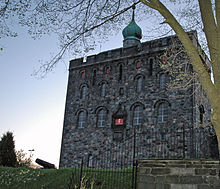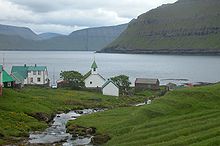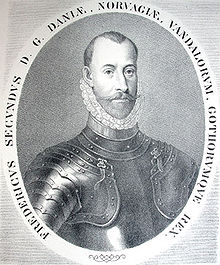- Magnus Heinason
-
Magnus Heinason Born 1545
Oyndarfjørður, Faroe IslandsDied January 18, 1589 (aged 44)
Copenhagen, DenmarkSpouse Sophia Axeldatter Gyhnterberg, (Norwegian) Parents Heine Havreki, Gyri Arnbjørnsdatter,  The Rosenkrantz Tower located on Bergenhus Fortress
The Rosenkrantz Tower located on Bergenhus Fortress
Magnus Heinason (or Mogens Heinesøn) (1545 – 18 January 1589) was a Faroese naval hero, trader and privateer. He was the son of Heine Havreki, a Norwegian priest from Bergen who emigrated to the Faroe Islands and who helped introduce the Lutheran Reformation to the Faroe Islands, and Gyri Arnbjørnsdatter, Havreki's second wife from a powerful and weathly Norwegian clan.
Magnus Heinason was engaged three times and married twice. Magnus had a son with a Faroese lady Kollfina in ca. 1560. Rasmus Magnussen (1560–1670) lived to the age of 110 years old, and at the age of 103 was himself father of a son. In 1580 Magnus met a Norwegian noble lady Margrethe Axeldatter Gyntersberg or von Güntersberg (1565–1589). They had a child Mogensbarn that died as child. They did not marry because she accused him of rape. The noble family then demanded that he marry Margrethe's younger sister, Sophie Axeldatter Gynhterberg (1566–1607). They married in 1582 in Bergenhus, Bergen and had one daughter, Elsebeth Magnusdatter (1584–1645).
Magnus Heinason served William the Silent and his son Maurice of Nassau, Prince of Orange for 10 years as a privateer, fighting the Spanish in the Dutch Revolt. Magnus Heinason was given the trading rights to the Faroe Islands by Frederick II of Denmark and Norway from 1559 to 1588. Later he received letters of marque to sink or capture pirate ships and English merchant ships.
Magnus built the first fortifications in Tórshavn. Only one year later, he was captured and sent to Copenhagen on the orders of the Danish Treasurer and Statholder, Christofer Walkendorf who was ruling Denmark at that time. Magnus Heinason was tried, and shortly thereafter he was beheaded. His remains were excavated and taken to Ørslev kloster where he lies to this day.
Contents
Early life
In his job as a priest in the Faroes, Magnus' father, Heine Havreki travelled much by sea, to and from the islands. Magnus accompanied him on these journeys. Even as a little boy Magnus knew how to sail small boats and gained a lot of experience that would be useful later in life. As a grown man in his career as a seaman and a privateer he would carry out some of his famous and finest acts in these same waters.[1]
Magnus the young man
 Maurice of Nassau, Prince of Orange - portrait by Michiel Jansz van Mierevelt
Maurice of Nassau, Prince of Orange - portrait by Michiel Jansz van Mierevelt
When Magnus was 17 or 18 years old his father was transferred to Norway. The family moved to Bergen, where Magnus lived out his dream of becoming a seaman, through family connections on his father's side. At a young age he was made captain of a trade ship on the route that his father had sailed for many years, Bergen to the Faroe Islands. On his third trip he was attacked by pirates. How this happened is not known but when he arrived in Bergen, people made him look an idiot for giving up without a fight. He was deeply hurt by this, and swore that he would take revenge. He left Norway and went to Netherlands in the Navy. Little is known about this part of Magnus’ life. Returning about 10 years later with commendations from Maurice of Nassau, Prince of Orange and his father William the Silent for bravery in combat at sea against the Spanish in the Dutch Revolt, that later resulted in the liberty of the Dutch people from the Spanish crown.[1]
Returning to Denmark
Magnus returned to Denmark with good recommendations from Maurice of Nassau, Prince of Orange, that he later in life would use when he met the Danish King, Frederick II of Denmark and Norway. It is likely that Magnus had a dream of moving back to Bergen and taking back his old job as captain on the trade route between Bergen and the Faroe Islands, with the difference that he would own the ship himself. The plan is very clear, while Magnus was in the Netherlands, his half-brother Jón Heinason was made Løgmaður, in 1571. But Magnus's dreams of getting the trade route rights or as said the monopoly rights to the Faroe Islands he must have been disappointed, because the Treasurer and Statholder (or in Danish, Rentemester), Christoffer Valkendorff had cancelled the old fashion of giving the rights out to private merchants. Now the ships that were trading on the Islands were sent by the royal trade and on their expense, so the monopoly started in 1578, the first year we first hear about Magnus’ returns home, he hears about this horrible way of trading.[1]
The monopoly
Magnus went to the King, to improve his position as a worthy man to take over the trade on the Faroe Islands, but the King was not pleased that he should give the monopoly trade away, now that he had purchased it for himself. But then Magnus used the excuse that someone owed him money on the Faroes, and he had to collect them!, he wanted the King to grant him a special travel pass, to one trip from Bergen to the Faroe Islands, so he could get what was his. The King couldn't see anything wrong in that since it was a man of word and honour that was standing in front of him. But before he gave him the free pass, he ensured that Magnus wouldn't trade goods even though if the people that owed him money, didn't have any and would give goods instead, he would had to bring all the goods with him to the king and hand them over. Magnus agreed, the King granted the trip and Magnus left Copenhagen, in the beginning of his return to his old home country, he tries to bend the rules of his journey, but he had other plans in mind. He had talk with several of the farmers and high standing people on the Faroes including his half brother Løgmaður Jógvan Heinason the high Judge of the Faroes, and talked them into a kind of a small rebellion against the newly started monopoly trade! And Magnus had success. The claims of the people on the Islands to the king were, that instead of the king leading the trade, a supervisor should take care of the books and make sure everything was legal. If the King wouldn’t agree to this claim, the Faroese people, asked for that there should be a man on the Islands holding a ship in command of his own, so he could travel between the Faroe Islands and Bergen to trade timber and weeds, since there were a constant lack of this on the Islands since the new trade ways were started.
On the ting no names where said, but it was clear what they had in mind. the Faroese claims were presented to the King, in December 1578 in Koldinghus, the Faroese men that had travelled all the way to Kolding, said that they would like a man named Magnus Heinason as the commander of these ships. The King wouldn’t take this decision himself instead he handed it over to his Treasurer and Statholder Christoffer Valkendorff to make a count of what would be best for the King since it was Christoffer Valkendorff that had proposed the King to start the Royal Monopoly trade. Meanwhile Christoffer and the clerks were counting and checking books for some days Magnus made good friends with king Frederick II of Denmark and Norway. And any way what number Christoffer ended on, or how the loss where, course Magnus had talk Frederik the II, into grant him the command of the ships and give him the trade rights. And then Christoffer Valkendorff's plan of making monopoly trade on the Faroes were gone. The Faroese now would send all goods that were produced in the Faroe Islands, with ships owned by Magnus Heinason and in return all goods needed on the Islands, timber, beer, weeds, would be provided by Magnus’ fleet!
Pirates raiding Tórshavn
In the summer of 1579 Tórshavn was raided by a Scottish pirate named Klerck. Magnus first heard of this when he landed in Tórshavn. The Scots had taken most of the King's taxes, and also a lot of private goods that were stored in Tórshavn. Magnus had lost goods that were meant to be sold and then taxed by the King. Magnus left the Faroe Islands and went to Denmark to make his case in front of the King. He wanted the King to cover the loss of the goods since Magnus had paid for them and the King would receive taxes of them. The King agreed to cover half the loss and Magnus the other part. Magnus was not pleased by this, so he made a proposal to the King, that he could arm his merchant ships with cannons, so that he could fight the pirates or at least take them prisoner and take them to shore for trial. Since he had served in war in the Dutch navy, and had fine recommendations from Maurice of Nassau, Prince of Orange, King Frederick II of Denmark and Norway agreed. Furthermore King Frederick mentioned the Oresund taxes, that he said were losing money on, especially because Dutch merchants were sailing the northern way around Norway into the White Sea to trade with Russia, instead of going the short way between Denmark and Sweden through Oresund. So Magnus got letters of marque to stop and take prize any ship that indented to travel north around Norway. But with the rule that Magnus did not attack any merchant or navy vessels of any nation if they were travelling the "right way".
Literature
The Faroese priest Lucas Debes commented in his lifework Færoæ & Færoa Reserata:[2]
Even travelled in Norway and on the Faroe Islands, this Magnus Heinesen`s death, his fellow countrymen were deeply in sorrow. The Faroese people say that he was a man who protected the Islands, his father came here and settled here, his brother and sister was born here, and they lived and died here, and thereafter his descendants and friends also live here.—Lucas Debes, Færoæ & Færoa ReserataReferences
- ^ a b c Troels Lund: „Heinesen, Mogens“ (et tidsbillede af det sekstende århundrede): gyldendals 1911 on page. 27-30
- ^ Lucas Debes Lucas Jacobson Debes: Færoæ & Færoa Reserata: Natural and Political history of the Faroe Islands. In Danish original from 1673. Translated to German by C. G. Mengel, in Copenhagen / Leipzig 1757. A new version is commented by, Norbert B. Vogt. Mülheim a. d. Ruhr: 2005. S. 129 [211] ff.
- Family tree of Magnus Heinason (Norwegian)
- Norden.no: Artikkel om Magnus Heinason (Norwegian)
- Dansk Biografisk Leksikon (Norwegian)
- Norbert B. Vogt's biographic Footnote 535 on page 129
- John F. West: Faroe - the emergence of a nation. London/New York 1972
Categories:- Faroese people
- 1545 births
- 1589 deaths
Wikimedia Foundation. 2010.


